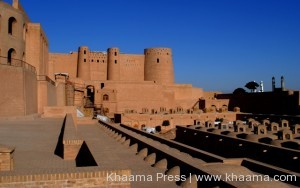Aga Khan Trust for Culture restores the historic Citadel in Herat 2014-07-12
An insight into the restoration project of one of Afghanistan’s most impressive historic sites: the Herat Citadel – dating back to Alexander the Great.
This story discusses the importance of Afghanistan’s historic sites and the restoration work being commenced by the Aga Khan Trust for Culture in Afghanistan.
Ajmal Maiwandi, the Chief Executive Officer for the trust, based in Kabul, explains a little bit about the history of the Herat Citadel, and why it is important for the future of Afghanistan to make culture and history accessible in this way. Abdul Ghaffoor Sheikhzada, Director of the National Museum of Herat (housed inside the Citadel), gives a tour of the site explaining some of the more detailed points of historic interest.
Abdul Ghaffoor Sheikhzada, Director, National Museum of Herat, said, “The Citadel of Alexander is one of the most historical landmarks in Herat. It is 3,300 years old. It does not just belong to the people of Herat. It is also a symbol of pride for the whole of Afghanistan.”
Ajmal Maiwandi, Chief Executive Officer, Aga Khan Trust for Culture Afghanistan, said, “Our Trust for Culture has been active since 2002 restoring some of Afghanistan’s most historic and important public sites. The site is a massive site located in the northern quarter of the Old City, which is roughly a square city, one kilometre by one kilometre.
It is a very old site, originally laid out, we think, prior to Alexander the Great, but reinvented and enlarged over time. The Upper Citadel would have been where the royals or the ruling classes would have lived, the Lower Citadel was where the trusted bodyguards and the military and the generals and other classes would have occupied.”
“This was the King’s summer bedroom. It is very cool and chilled because the wind blows through here,” Sheikhzada said.
He also added, “I believe that this was the King’s bathroom. I have heard that he often bathed in milk here.”
“The Citadel shows us the history of wars that have happened here, the power and wealth of Afghanistan in the past. Now it is our responsibility to protect this Citadel,” Sheikhzada said.
“The history in Afghanistan has a very particular role. It can be divisive in many ways, but also it can be something that brings people together. Our shared and common history. Afghanistan has a very diverse people. There are multiple ethnic groups, multiple languages, multiple cultures.
And I think our history shows us that in past times we have been able to coexist, not only coexist but flourish. Cities like Balkh, cities like Herat, Ghazni show that the centre of very, very advanced and cultivated and cultured civilisations were once in Afghanistan. And I think it’s that history that we look to when we look ahead at what Afghanistan can become,” said Ajmal Maiwandi, Chief Executive Officer Aga Khan Trust for Culture in Afghanistan.
This is the script of a NATOChannel story by Jack Somerville and Lauren Muchan
Follow Khaama Press (KP) | Afghan News Agency on Twitter, become a fan on Facebook. Stay updated via RSS
- 3412 reads
 Ismaili.NET - Heritage F.I.E.L.D.
Ismaili.NET - Heritage F.I.E.L.D.